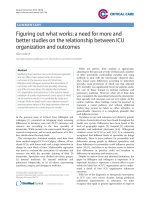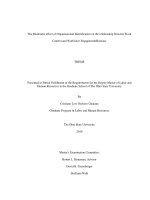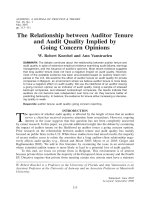Research on the correlation between forest management and climate change in bao thang district, lao cai province local peoples perception and potential uses of GIS technology
Bạn đang xem bản rút gọn của tài liệu. Xem và tải ngay bản đầy đủ của tài liệu tại đây (602.3 KB, 57 trang )
THAI NGUYEN UNIVERSITY
UNIVERSITY OF AGRICULTURE AND FORESTRY
DO THI HIEN
TOPIC TITLE: RESEARCH ON CORRELATION BETWEEN
FOREST MANAGEMENT AND CLIMATE CHANGE IN BAO THANG
DISTRICT, LAO CAI PROVINCE: LOCAL PEOPLE'S PERCEPTION AND
POTENTIAL USES OF GIS TECHNOLOGY
BACHELOR THESIS
Study Mode:
Full-time
Major:
Environmental Science and Management
Faculty:
International Training and Development Center
Batch:
K42-AEP
Thai Nguyen, 20 January 2015
I
Thai Nguyen University of Agriculture and Forestry
Degree program
Bachelor of Environmental Science and Management
Full name
DO THI HIEN
Student ID
DTN1053040044
Research on the correlation between forest management
and climate change in Bao Thang district, Lao Cai
Thesis title
province: local people's perception and potential uses of
GIS technology.
Assoc. Prof. Dr. Hoang Van Hung
Supervisor
Abstract
Bao Thang, located in the central of Lao Cai province and having Red river flowed
through, is a typical industrial district which is essential to the socio-economic
development of the province. As a result of industrial zone expansion, Bao Thang
environment and biodiversity are declined both in quality and quantity, especially forest
communities. Bao Thang forests recover from past clearing or heavy harvest, and forest
carbon stores are growing larger over time. However, the industrial emissions from
burning fossil fuels in the this district is captured only about 10% by forests. Although
private forest use in Bao Thang has been regulated, illegal deforestation still takes
place. This study seeks to assess current status of forest management practices and
effects of climate change by observing local people's perception on these fields as well
as to find out potential uses of GIS technology at local level. The results showed that
Bao Thang residents are highly aware of the climate change impacts and willingly to
take actions though some constraints still exist. Moreover, GIS is also applying in Lao
Cai as a whole, which promisingly will come to local level (Bao Thang in specific) in
the near future. In addition, the study suggested some recommendations specifically
suitable for study areas in order to improve sustainable forest management practice for
forest owners and managers.
Keywords
Bao Thang, GIS, Lao Cai, perception, sustainable forest
management
Number of pages
50
Date of submission
January 20, 2015
1
ACKNOWLEDGEMENT
The author thanks Mr. Do Van Hai for making this report accomplished. A
special appreciation to the local people who provided information, and to many K42
classmates, teachers from AEP office and lecturers including MSc. Nguyen Huu Tho,
Dr. Nguyen Manh Ha and Dr. Ho Ngoc Son, who provided guidance, critics and
encouragement. And finally, thanks to Assoc. Prof. Dr. Hoang Van Hung, who
enthusiastically reviewed and corrected this report into its final form.
Student
DO THI HIEN
2
TABLE OF CONTENTS
LIST OF FIGURES..................................................................................................................................5
LIST OF TABLES ...................................................................................................................................6
LIST OF ABBREVIATIONS ..................................................................................................................7
PART I. INTRODUCTION .....................................................................................................................8
1.1. Research rationale .........................................................................................................................8
1.2. Research's objectives.................................................................................................................. 10
1.3. Research questions ..................................................................................................................... 11
1.4. Limitations ................................................................................................................................. 11
PART II. LITERATURE REVIEW...................................................................................................... 12
2.1. Theoretical background.............................................................................................................. 12
2.2. Practical background .................................................................................................................. 20
2.2.1. Researches in the world.............................................................................................................20
2.2.2. Researches in Vietnam ..............................................................................................................21
PART III. METHODS .......................................................................................................................... 22
3.1. Material ...................................................................................................................................... 22
3.2. Methods...................................................................................................................................... 22
3.2.1. Survey questionnaires ...............................................................................................................22
3.2.2. Observation ...............................................................................................................................23
3.2.3. Data collection...........................................................................................................................23
PART IV. RESULTS ............................................................................................................................ 24
4.1. General description of the study area ......................................................................................... 24
4.1.1. Topography ...............................................................................................................................24
4.1.2. Geology .....................................................................................................................................24
4.1.3. Meteorology ..............................................................................................................................25
4.1.4. Extreme events ..........................................................................................................................25
4.1.5. Ecology .....................................................................................................................................25
4.2. Current status and climate change impacts ................................................................................ 26
4.3. Roles of forest in climate change ............................................................................................... 30
4.4. Survey results ............................................................................................................................. 31
4.3.1. Importance of climate change ...................................................................................................31
4.3.2. Impact of climate change ..........................................................................................................32
4.3.3. Adaptation and mitigation.........................................................................................................33
3
4.3.4. Support for climate change........................................................................................................34
4.4. Potential uses of GIS technology ............................................................................................... 34
PART V. DISCUSSION AND CONCLUSIONS................................................................................. 39
5.1. Discussion .................................................................................................................................. 39
5.2. Recommendation........................................................................................................................ 41
5.3. Conclusions ................................................................................................................................ 43
REFERENCES...................................................................................................................................... 44
APPENDIX ........................................................................................................................................... 47
Appendix 1. Survey questionnaires................................................................................................... 47
Appendix 2. Survey result summary (in percentage) ........................................................................ 52
4
LIST OF FIGURES
Figure 1: Bao Thang map
Figure 2: Lao Cai map
Figure 3: Land surface temperature map
Figure 4: Land cover map
Figure 5: Aspect map
Figure 6: Contour map
Figure 7: Digital Elevation Map
5
LIST OF TABLES
Table I: Forest status quo of study areas in Bao Thang district, 2013 (ha)
Table II: Temperature and precipitation changes in 21st century
Table 1: Gender
Table 2: Time living and working in this Bao Thang
Table 3: Residents' awareness of climate change over the last few decades
Table 4: The trends of changes, driven by climate change and/or other forces
Table 5: The importance of climate change compared to the other challenges
Table 6: Effects of climate change
Table 7: Aspects affected by climate change in the next decade
Table 8: Awareness of national policies, strategies or legislation aimed at climate
change that have a direct or indirect impact on the forest sector
Table 9: Respondent percentage implemented modifications to forest management
plans or practices due to the impacts of climate change
Table 10: Awareness of effects of climate change on forests and the options for
climate change adaptation and mitigation
Table 11: Willingness to undertake climate change adaptation and mitigation actions
Table 12: The greatest constraints limiting forest managers' ability to undertake
climate change adaptation and mitigation actions in Bao Thang
Table 13: Necessary assistance to address climate change in your area?
Table 14: Support acquisition to forest management and climate change issues
6
LIST OF ABBREVIATIONS
UNEP: United Nations Environment Program
RS: Remote Sensing
GIS: Geographic Information System
LULC: Land Use and Land Cover
AR4: The fourth Assessment Report
IPCC: the Intergovernmental Panel on Climate Change
UNDP: United Nations Development Program
REDD+: Reducing Emissions from Deforestation and Forest Degradation
GHGs: Greenhouse Gases
RECOFTC: Regional Community Forestry Training Center for Asia and the Pacific
NGOs: Non-governmental Organizations
7
PART I. INTRODUCTION
1.1. Research rationale
Almost every nation has been addressing the threat of severe climate change,
mostly through policies aimed at reducing the buildup of greenhouse gases. Natural
ecosystems, counting forests - a critical link in the global carbon cycle, play a vital
role in the mitigation of global warming. Forests are crucial both for their large
existing reservoirs of carbon (called “pools” or “sinks”) and because of the ongoing
net flow of carbon from the atmosphere into that forest reservoir called “flux”. As
consensus grows about the accumulative, grave impacts of climate change, the role of
forests in carbon storage is increasingly recognized as one of the easiest options to deal
with these effects. Better or sustainable forest management is thus one of the foremost
strategies to mitigate global climate change.
Forest is a precious resource needed to maintain current conditions of
environment as well as to meet the needs of human beings by supplying multiform of
resources. It is a part several cycles on Earth such as water and carbon ones. However,
since human population increases with considerable growing rate and high density
particularly in urban areas, people tend to exploit more and more to ensure food
security, firewood and raw material for the socio-economic development, putting
pressure on natural resources in general and forests in specific. Thus, the decline of
forest resources has become a common and pressing issue of the world, especially for
developing countries including Vietnam which is well-known with high hills and
mountains and 14th place in population. Recently, overexploitation and natural
disasters such as landslides and fires are causing forest resources deteriorated
8
substantially in both quantity and quality, leading to air, water and soil problems due
to the loss of CO2 storages, soil erosion, land use change, and unbalanced natural
cycles, which results in the influence on economic, public health, and social benefits
that these ecosystems provide. The challenge for humans and modern science is to
understand and regulate the effects of these changes, and the complex interaction
between human and biotic systems at various scales, typically at local level to acquire
more accuracy. Improving local people's understanding and knowledge of the
consequences of land use and land cover change is a critically important to address the
current major science issues relating to climate change.
Contemporary, Vietnam is facing with many environmental problems that have
impacts on socio-economic development at local and national levels. The increase of
carbon dioxide in the atmosphere exaggerates climate change process, thus more
extreme weather events, such as tropical storms, floods and droughts take place. Those
natural disasters have become a pressing issue for Vietnam government who is in
charge of the people’s prosperity as well as for future development of the country.
Lao Cai, one of the provinces situated on the Sino-Vietnamese borderline in the
northwestern part of the country, is home to some vast expanse of primal forests with
several kinds of rare timber plants such as Po Mu ( Fukiena), Lat Hoa (Chukrasia
Tabularis), and Cho Chi. The province is also the habitat of many kinds of medicinal
herbs and rare animals including deer, wild boar, tigers and others. However, the rate
of forest degradation in the area is exacerbated by human activities. Topography of
Lao Cai is very diversified with rivers, high mountain peaks, steep and high mountain
passes, deep streams and wide valleys but it is also one of the obstacles to apply
modern technology in environmental monitoring. Bao Thang, located in the central of
9
the province and having Red river flowed through, is a typical industrial district which
is essential to the socio-economic development of Lao Cai. As a result of industrial
zone expansion, Bao Thang environment and living organisms are put in danger,
especially forest communities. Bao Thang forests recover from past clearing or heavy
harvest, and forest carbon stores are growing larger over time. However, the industrial
emissions from burning fossil fuels in the this district is captured only about 10% by
forests.
Until now, much of the climate warming research has been on a global and
regional level. It is necessary to conduct more researches at local level. However, our
understanding of historical changes in Bao Thang forests is inadequate. Thus,
improving future understanding status quo of the environment typically through local
people's perception is needed for further researches and sustainable natural ecosystem
management.
The study not only will be beneficial for local people by providing them
foundation on forest management and climate change, but also act as a primary source
of data for further study, research and management in the future.
1.2. Research's objectives
The research focused mainly on surveying and interviewing local people in Bao
Thang district with the following objectives:
- Identifying current status of forest management and climate change impacts in
Bao Thang district, Lao Cai province
- Identifying local people's perception on forest management and climate change
adaptation and mitigation actions
- Identifying the potential uses of GIS technology in the study area
10
- Recommending possible intervention actions and suggestions for further
research and better management practices in the study area.
1.3. Research questions
The research was conducted in Bao Thang district - located at 22°22'56"N and
104°10'38"E, Lao Cai province from September to December. It focused on agevarying indigenous people, immigrants, and those who are working in the district and
the feasibility to apply GIS and technology at the local scale.
Local people play an important role in forest protection but it is often neglected.
Their perspectives on climate change and forest conditions and management practices
should be considered as a crucial factor in order to seek for the optimally suitable
solutions for the district environment. Moreover, modern technologies are available
such as GIS and remote sensing. A study with the involvement of local people and
application of GIS technology is important to address relevant issues on forest
management and climate change in Bao Thang to answer the question: what trends can
we expect in our forests if the climate becomes drastically warmer in 2050?
1.4. Limitations
Inadequate data is one of the limitations that the thesis only covered the general
problems rather than intensive studies. Moreover, the mountainous and sloping
topographic structure of the region and negative climate conditions caused difficulties to
find usable (not cloudy) satellite images. These problems were tried to be eliminated by
independently applying supervised classification change detection technique to the
images.
11
PART II. LITERATURE REVIEW
2.1. Theoretical background
Climate is the long-term weather pattern (for at least 30 years) in an area,
including general patterns and extremes of drought, rains, storms, and freezing
temperatures (Waskey, 2008). Or in other words, climate is the interaction of all of the
components of the Earth’s system and it includes the solar and infrared radiation and
sensible and latent heat fluxes that are all impacted by changes in the Earth’s surface
(Pielke 2002).
A greenhouse gas is a gas in an atmosphere that absorbs and emits radiation
within the thermal infrared range. This process is the fundamental cause of greenhouse
effect. The primary greenhouse gases in the Earth’s atmosphere are water vapor,
carbon dioxide (CO2), methane (CH4), nitrous oxide, chloro-floro-carbons (CFCs) and
ozone. Greenhouse gases greatly affect the temperature of the Earth, without them,
Earth’s surface would be about 33ºC colder than the present average of 14ºC.
A critical and perhaps the dominant global environmental problem in the last
three decades is global warming, resulting from global climate change (Scholz and
Hasse, 2008). Global warming is an increase in Earth’s average surface temperature,
due mostly to the release of greenhouse gases into the atmosphere by human-fuelled
activities such as increased fossil fuel consumption (Benson, 2008). Climate change is
the long-term change in global weather patterns, associated especially with increases
in temperature, precipitation, and storm activity (Benson, 2008).Climate change is a
direct consequence of the continued increase in the atmospheric CO2 mainly resulting
from the anthropogenic emissions from fossil fuel burning (Cox et al., 2000; Post et
al., 2004; Lehmann, 2007; Scholz and Hasse, 2008; Sheikh et al., 2011).
12
Recent changes in climate have already had significant impacts on biodiversity
and ecosystem in certain regions. As climate change will become more severe, the
harmful impacts on ecosystem services are expected to outweigh possible benefits,
such as a longer growing season, in most regions of the world. Climate change is
expected to exacerbate risks of extinctions, floods, droughts, population declines, and
disease outbreaks. Climate change can result in significant land use change and land
cover shift (Briner et al., 2012), aggravate drought (Kassas, 1995) and modify the
capacity of the ecosystem to provide ecosystem goods and services (Briner et al.,
2012). The effects of climate change range from ―shifts in ice freeze and break-up
dates on rivers and lakes; increases in rainfall and rainfall intensity in some areas with
reversal
in
other
areas;
lengthening of growing seasons; and precipitation of flowering of trees, emergence of
insects, and egg-laying in birds (Pittock, 2009). The eventuality of these is that human
survival is threatened.
The significant role of the land within the climate system should not be
surprising. Forests play an important role in carbon cycle. Apart from this role, tropical
forests provide numerous additional ecosystem services in which many of them
directly or indirectly influence climate. The climate-related ecosystem services that
tropical forests provide include the maintenance of elevated soil moisture and surface
air humidity, reduced sunlight penetration, weaker near-surface winds and the
inhibition of anaerobic soil conditions. Clear-cutting a forest, for instance, boosts
respiration (releasing CO2) and suppresses photosynthesis (reducing biological
fixation of CO2) for several years or decades—even when land is replanted or allowed
13
to regenerate trees. Large existing stores of carbon are released into the atmosphere
when land is converted to other uses. Since more land is developed, drained, or
otherwise converted annually than is restored to its natural cover.
Forest ecosystems play multiple roles at global as well as local levels: as
providers of environmental services to nature in general, humans in particular, and as
source of economically valued products (UNEP 2002). Forests especially natural
forests are used for various ecological and economic purposes. They could maintain
local climate, regulates hydraulic cycle, used as wild life habitats and reduce runoff
and soil erosion. The economic importance of forests includes supply of raw material
for pulp and paper, provision of timber for construction and other activities and used
as fuel wood for energy source. Therefore, depletion of this important natural resource
will affect other valuable and life supporting 26 resources like water and soil. In
addition to these, the climate change and biodiversity will also be greatly affected by
deforestation. It is very strategic and wise approach to avoid other problems by solving
this key problem.
According to James W. Moore (1986), deforestation is one of the major causes
of land cover change and it is the most pervasive concerns in developing countries,
especially in tropical moist forests, which covers some 550 million ha of the globe,
with an annual harvesting rate of over 2%. So that the forest cover of the world is
declining continuously and have global environmental implications. He indicated the
world wide consequences of deforestation as - change in the way of life of local
people, extinction species, loss of undefined reservoir of genetic resources, increased
erosion from wind and water, and increased desertification; increased runoff to rivers,
14
resulting in flooding and future erosion; reduced transpiration from vegetation and
thus less precipitation, and change in the regional Albedo.
Biodiversity refers to the variability among living organisms from all sources,
including terrestrial, marine and other aquatic ecosystems, the ecological complexes of
which they are part. It will include diversity within species, between 30 species and of
ecosystems (UNEP 2002). Ecosystem services are the benefits people obtain from
ecosystems. Biodiversity plays an important role in the way ecosystems function and
in the many services they provide. Services include nutrient and water cycling, soil
formation and retention, resistance against invasive species, pollination of plants,
regulation of climate, as well as pest and pollution control by ecosystems. For
ecosystem services it matters which species are abundant as well as how many species
are present (Facts on Biodiversity 2005).
Vegetation provides a range of ecosystem services such as food and shelter for
wildlife, and it controls the Earth’s climate by regulating evapo-transpiration and
sequestration of carbon (Czerepowicza et al., 2012). Vegetation however is
increasingly endangered mainly due to anthropogenic and climatic influences (Steven,
2001).World forests increasingly appear finite, vulnerable, dangerously diminished,
perhaps already subject to irreparable damage (Steven, 2001). A most significant
intellectual challenge to ecologists and bio-geographers is to understand vegetation
spatial temporal patterns (Liu, 2007). RS is one of the widely used approaches for
providing scientific evidence of vegetation change (Omuto, 2010). Classification and
change detection carried out showed accelerated land degradation of the grassland
15
around the salt-affected soil near the water bodies due to variation in water sizes as a
result of both climate change and anthropogenic activities.
Land use and land cover change affects a wide range of human and natural
systems and contributes to changes in carbon exchange and climate through a range of
feedbacks. Future changes in LULC are a function of numerous driving force
variables. Biophysical conditions, population change, economic activity and growth,
societal attitudes, governance, and regulatory regimes are all important drivers of
change, interacting to create unique and dynamic LULC mosaics functioning at a
range of geographic scales. LULC scenario development, coupled with spatially
explicit LULC modeling, has emerged as a useful framework for investigating
alternative futures of land use and land cover and the potential impacts of Earth
systems.
Land use and land cover change is now recognized as a major force of
environmental change. It affects ecosystem function, biodiversity and habitat, water
quality and quantity, and is a forcing and feedback factor to climate change, among
numerous other consequences that range from dust flux to forest fragmentation. This
project specifically contributes to understanding the status, trends, and consequences
of land change across the ecological regions of the Lao Cai province.
The 2007 fourth Assessment Report (AR4) compiled by the Intergovernmental
Panel on Climate Change (IPCC) noted that “changes in atmospheric concentrations of
greenhouse gases and aerosols, land cover and solar radiation alter the energy balance
of the climate system”, and concluded that “increases in anthropogenic greenhouse gas
16
concentration is very likely to have caused most of the increases in global average
temperatures since the mid-20th century”.
Reducing the risks caused by climate change is an immense challenge.
Scientists, policy makers, developers, engineers, and many others have used
geographic information system (GIS) technology to better understand a complex
situation and offer some tangible solutions. Technology offers a means to assess, plan,
and implement sustainable programs that can affect us 10, 20, and 100 years into the
future (Dangermond and James Baker 2010)
“GIS is an integrated system of computer hardware, software, and trained
personnel linking topographic, demographic, utility, facility, image and other resource
data that is geographically referenced.” ~ NASA
Remote sensing is the science of deriving information about an object from
measurements made at a distance from the object without actually coming in contact
with it. The quantity most frequently measured in present day remote sensing systems
is the electromagnetic energy emanating from the objects of interest and although there
other possibilities such as seismic waves, sonic waves and gravitational force.
Remote sensing and GIS are being increasingly used in combination spatial
analysis. GIS databases are used to improve the extraction of relevant information
from remote sensing imagery, whereas remote sensing data provide periodic pictures
of geometric and thematic characteristics of terrain objects, improving our ability to
detect changes and update GIS databases (Janssen, 1993 In Luis M. T. et al., 2003).
Human activity is vastly altering the Earth’s vegetative cover. Such changes
have considerable consequences for the health and resilience of ecosystems and for
human welfare. They also contribute to anthropogenic climate change through a
17
variety of processes. These include the growth or degradation of surface vegetation,
which produces changes in the global atmospheric concentration of carbon dioxide;
and changes in the land surface, which affect regional and global climate by producing
changes in the surface energy budgets (Gregg, 2003).
From a plethora of definitions, RS is defined in this study according to Janssen
(2004) as the process of acquiring data on characteristics of the Earth’s surface by a
device (sensor) that is not in contact with the objects being measured and the
processing of the data.GIS is the information tied to the earth’s surface (including the
zones immediately adjacent to the surface, and thus the subsurface, oceans, and
atmosphere) (Longley et al., 1999).RS enables the acquisition of large-scale
comprehensive datasets whereas GIS provides a means of displaying, overlaying,
combining data from other sources and analyzing the data (Chapman and Thornes,
2003).
Geographical information systems (GIS) and remote sensing are wellestablished information technologies, the value of which for applications in land and
natural resources management are now widely recognized. They are, however, still
essentially separate technologies and practitioners still generally consider themselves
primarily involved with one or the other. Current technologies such as geographical
information systems and remote sensing provide a cost effective and accurate
alternative to understanding landscape dynamics. Digital change detection techniques
based on multi-temporal and multi- spectral remotely sensed data have demonstrated a
great potential as a means to understanding landscape dynamics- detect, identify, map,
and monitor differences in land use and land cover patterns over time, irrespective of
the causal factors. Recent improvements in satellite image quality and availability have
18
made it possible to perform image analysis at much larger scale than in the past. GIS
has enormous possible as an environment for the conception of dynamic models of
physical environmental processes.
Adaptive actions are adjustments in assets, livelihoods, behaviors, technologies,
or policies that address ongoing and future climate changes (IPCC, 2007; Stern, 2006;
UNDP, 2007; Smit and Wandel, 2006). Adaptation confers private benefits--it is in
people's self-interest to adapt in order to safeguard lives and livelihoods. Adaptive
actions comprise both private, club, and public goods. Heltberg, Siegel, and Jorgensen
(2009) define adaptive capacity as the ability to deploy social risk management
strategies for reduction of risk and human vulnerability associated with climate
change. The drivers of adaptive capacity include physical, financial, human, and social
capital. Adaptive capacity is unequally distributed: it varies systematically along
existing fault lines for inequality and social exclusion such as gender, ethnicity, and
socio-economic status (Ribot, 2010).
Climate change adaptation is living with climate change. It is an automatic or
planned response to climate change that minimizes the adverse effects and maximizes
any benefits (Pittock, 2009). Strategies for climate change adaptation include loss
bearing, loss sharing, climate change threat modification, effect prevention, change in
land-use or activity, location change, furtherance of research on better methods of
adaptation and behavioral change (Pittock, 2009). Going by the range of options of
adaptation, it is rational to settle for prevention rather than cure.
19
2.2. Practical background
2.2.1. Researches in the world
There are thousands of researches in the world in association with GIS
application and forest management. Including, "The use of remote sensing and GIS
methods for mapping land cover change in Scotland" was conducted to seek for
qualified changes in land cover and habitats, important for wildlife in Scotland.
In 2000, A GIS based integrated land use/ cover change model to study human land interactions project was carried out to develop a suitable model to explain the
changes in the land use patterns and the resulting land cover and also to forecast them
in Japan.
IPCC completed the research named exploring climate patterns embedded in
global climate change datasets to explore the analysis of climate patterns embedded in
the Global Climate Data Sets generated by the Community Climate System Model
(CCSM) for the 4th Assessment Report.
In 2011, Mapping vulnerability to climate change project was conducted under
the support from World Bank to develop a methodology for regional disaggregated
estimation and mapping of the areas that are ex-ante the most vulnerable to the impacts
of climate change and variability and apply it to Tajikistan, a mountainous country
highly vulnerable to the impacts of climate change.
In 2012, there was a research on forest management and climate change:
stakeholder perception conducted by the Forest and Climate Change program of FAO
to provide timely information and tools to a wide range of stakeholders, with the
ultimate objective of assisting countries' efforts to mitigate and adapt to climate change
through actions consistent with sustainable forest management.
20
2.2.2. Researches in Vietnam
Research named estimation of biomass for calculating carbon storage and CO2
sequestration using remote sensing technology in Yok Don National Park, central
highlands of Vietnam was conducted in 2012 to estimate biomass and carbon stocks in
tropical forest using remote sensing data for dry forest of central highlands of
Vietnam.
Vietnam Ministry of Natural Resources and Environment generated the climate
change and sea level rise scenarios to all provinces in the country in order to provide
all general information for future trends in association with socio-economic
development.
21
PART III. METHODS
The research was conducted from September to December 2014 in Bao Thang
district, Lao Cai province. The final results were processed by using computer room
and laboratory in Lao Cai Community College.
3.1. Material
To identify potential uses of GIS technology, researcher used remote sensing data
downloaded from online website then developed Bao Thang maps: Satellite image was
used as a primary source of data for the study area. Applying GIS and remote sensing
technology to develop maps associated with altitude, temperature, land cover and
aspect for evaluation of correlation between land cover and climate change in Bao
Thang district, Lao Cai province, Vietnam. Images were downloaded from an online
website for free, then validated and edited through some checking and correction
processes. After that, they were converted from vector to raster and generalized and
classified before integration step to create a map. Finally, the maps were enhanced by
adding title, scale, key, map symbolism, and draping overlays and exported into an
image file.
3.2. Methods
3.2.1. Survey questionnaires
From September to November 2014, 100 randomly chosen local people,
involving forest owners, indigenous people, and others living and working in the
research area from 3 towns to represent a range of conditions across the region,
including Tang Loong (40 people), Pho Lu (30 people), and Phong Hai (30 people),
were surveyed and interviewed (survey questionnaires attached in appendix 1).
The survey recorded their observations of climate change impacts and the ability
to address related needs and created a summary of the survey results (appendix 2).
22
Percentage distribution was used to analyze questionnaires. Information on the
socio-economic conditions of 100 selected households will be used to identify the
underlying factors and explain the effects of changes.
3.2.2. Observation
The researcher gathered information by recording behavioral patterns, lifestyle, and
belief in 3 towns of Bao Thang district, Lao Cai province, including Pho Lu, Tang Loong,
and Phong Hai towns. Studies were carried out to have a detailed examination of the site
in order to fully understand and depict experiences through examination and cross
comparison of towns: what is there and how it got there.
3.2.3. Data collection
From September to October 2014, the author searched for information on
background, development, current conditions, and environmental interaction of forest
change and natural phenomena observed, recorded, and analyzed in order to complete
description of present phenomena from Bao Thang Division of Natural Resources and
Environment and Bao Thang Forest Protection Division.
23
PART IV. RESULTS
4.1. General description of the study area
4.1.1. Topography
Bao Thang, a rural district of Lao Cai Province in the northeast region of
Vietnam with average altitude ranging from 80 to 400 meters, has Red river flowing
through. Bao Thang topography includes a narrow valley strip that runs along Red
river; the west is the low mountain range of Fansipan mountain; the east is the low
mountain range of An Ngu mountain in the upper Red river. The Red river flowing in
district domain has 42 kilometers long and divides Bao Thang into 2 regions - right
bank and left bank. The right bank has numerous big streams originating from
Fansipan mountain, resulting in favorable conditions for waterway transportation, such
as Ngoi Bo, Ngoi Nhu, Suoi Nhon, Suoi Trat etc. In general, the streams in Bao Thang
are sloping with unequal and rather rough water flow along mountain and hill sides.
Many groundwater streams run out from mountains consistently, which benefits local
people with trenches for irrigation and daily life.
4.1.2. Geology
According to the results from geology survey conducted by Joint-Stock
Environmental Geology Company in 2008, the features of soil gradation are as
following:
- Layer 1: mixed firm clay which has red brown and yellow grey colors
- Layer 2: raw aggregated sandstone moderately to strongly weathered by wind and
water
24






![brown and calor - 2004 - the correlation between corporate governance and company performance [cgs-fp]](https://media.store123doc.com/images/document/2015_01/02/medium_izzlTXr0MM.jpg)
![gherghina et al - 2014 - a study on the relationship between cgr and company value - empirical evidence for s&p [cgs-iss]](https://media.store123doc.com/images/document/2015_01/02/medium_JKXoRwVO1T.jpg)

